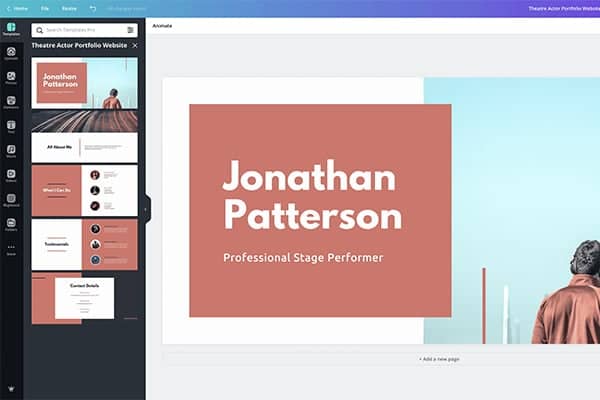Essential Tips for Crafting High-Impact Web Site Styles
In the realm of digital marketing, the style of a site serves as an important touchpoint for engaging prospective clients. To produce high-impact website styles, one have to consider vital components such as target market understanding, customer experience, and visual power structure.
Understand Your Target Market

To successfully recognize your target market, start by carrying out demographic evaluations to collect information on age, sex, place, and passions - website design. This info offers as a foundation for producing individual personas, which stand for the key features of your target market. These personas overview decision-making in style elements and content method, guaranteeing alignment with user assumptions
Furthermore, evaluating customer actions through devices like Google Analytics can disclose how site visitors interact with your website. Metrics such as bounce rates and time on page can highlight locations that need enhancement or adjustment. Individual surveys and feedback also supply vital insights into preferences and discomfort points.
Inevitably, a deep understanding of your audience is not simply helpful yet vital. It empowers developers to create more appropriate, appealing, and practical websites that promote a favorable user experience and drive wanted outcomes.
Prioritize Customer Experience
When developing a site, prioritizing user experience (UX) is paramount to attaining both user contentment and company purposes. A well-crafted UX ensures that visitors can navigate the site easily, find the details they require, and involve with content efficiently. To complete this, it is vital to take on a user-centered design strategy that includes understanding user needs, choices, and actions.
Start by conducting comprehensive research study, including customer surveys and use testing, to gather understandings into just how customers communicate with your website. This information ought to notify style decisions, making certain that attributes and designs align with customer assumptions. Streamlined navigation is crucial; site visitors ought to have the ability to find info swiftly without unneeded clicks or complication.
Furthermore, think about the filling rate of your web site. A slow-loading site can bring about high bounce prices, adversely influencing customer experience. Optimize scripts and pictures to enhance efficiency.
Last but not least, ensure that your internet site is accessible to all individuals, consisting of those with impairments. Following access standards not just widens your audience yet additionally fosters inclusivity. By focusing on UX, you lay the foundation for a successful internet site that meets both customer needs and service goals.
Embrace Visual Pecking Order
A well-structured visual power structure plays a significant function in improving individual experience by guiding site visitors' attention to one of the most important aspects of a web site (website design). By purposefully preparing material, developers can create a clear path for individuals to comply with, guaranteeing they engage with vital details effectively
To implement aesthetic power structure, start by using dimension and range. Bigger components normally draw the eye, making them best for headings or calls to activity. Enhance this with contrasting shades that highlight essential areas, as lively colors can create centerpieces that capture interest.
Additionally, the placement of components on the page is important. Leading the customer's gaze via the format can be accomplished by placing important information at the leading or in the center, where individuals typically begin their aesthetic journey. Integrating whitespace around elements can additionally improve clearness, making it easier for customers to refine information without really feeling overwhelmed.
Finally, employing typography properly adds to visual power structure. Different font style dimensions, styles, click resources and weights can denote value, leading users with the material seamlessly. By embracing these concepts, developers can develop an user-friendly experience that cultivates engagement and urges customers to discover further.
Enhance for Mobile
Mobile optimization is vital in today's digital landscape, as a considerable part of internet traffic originates from you can find out more smart phones. To ensure a seamless customer experience, websites should be designed with mobile customers in mind. This entails using receptive website design methods that adjust the format, photos, and text to fit different screen dimensions while maintaining performance and aesthetics.

Touch targets, such as buttons and web links, should be suitably sized, ensuring they are easily tappable without errors. Furthermore, make certain that types are mobile-friendly by reducing input fields and making use of dropdowns where appropriate, improving the user experience.
Last but not least, test your website across different mobile phones and internet browsers to recognize any kind of issues that may impact functionality. By focusing on mobile optimization, you not only boost user contentment however likewise favorably affect your website's online search engine ranking, therefore attracting even more visitors and improving total involvement.
Implement Solid Branding
A well-defined brand not just differentiates you from rivals however also fosters depend on and commitment amongst your audience. This identification should be shown regularly across all digital touchpoints, including your internet site, social media, and email interactions.
Aesthetic aspects such as logo designs, color pattern, and typography play an essential role in branding. Pick a color scheme that resonates with your target market and reflects your brand name individuality. Make sure that your logo is functional and plainly shown on your website, enhancing brand recognition.
Content is just as crucial; look here your intonation need to line up with your brand identification, whether it's expert, pleasant, or authoritative. Involving narration can even more strengthen your brand name, developing an emotional link with customers.
Final Thought
In conclusion, crafting high-impact internet site styles requires a complex method that includes comprehending the audience, focusing on individual experience, and welcoming aesthetic power structure. By integrating these components, sites can properly engage individuals, facilitate seamless navigating, and foster emotional links that boost brand identity.
To develop high-impact site designs, one should take into consideration necessary elements such as target market understanding, customer experience, and visual pecking order.When designing a site, focusing on individual experience (UX) is extremely important to attaining both user fulfillment and service goals.Start by carrying out complete research, consisting of user studies and usability screening, to gather insights right into how customers connect with your site. To guarantee a smooth user experience, internet sites need to be created with mobile users in mind.In final thought, crafting high-impact website styles necessitates a diverse technique that incorporates comprehending the target market, focusing on customer experience, and welcoming aesthetic hierarchy.